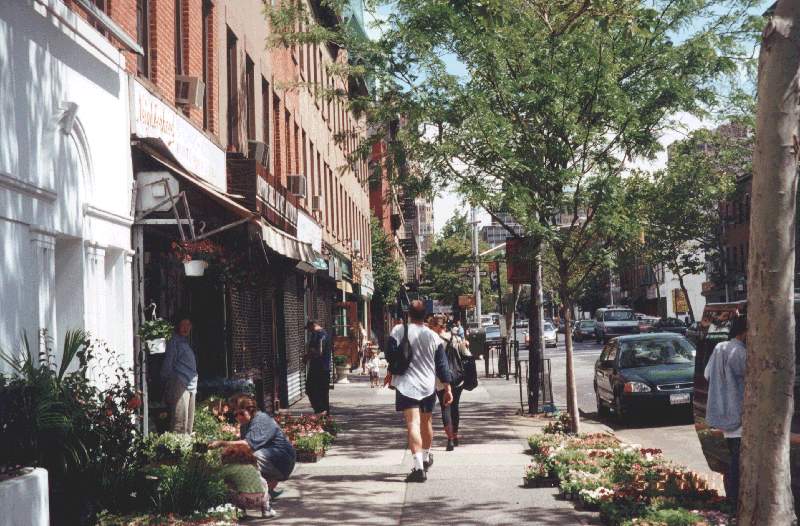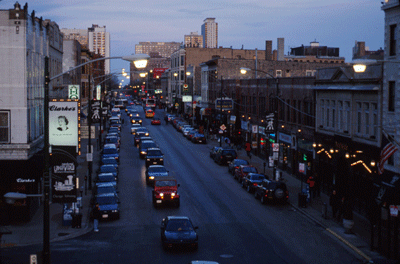Zoning for a Better Chicago: MPC Zoning Reform Recommendations

Introduction
— regulating only bulk, use and density — that its application results in negative unintended consequences for local communities. Mayor Richard M. Daley’s effort to update the 45-year-old code creates the perfect opportunity to inject new life and vitality into Chicago’s neighborhoods. A new code can positively guide the forces of development by encouraging expanded housing options, urban design guidelines, transit-oriented development and neighborhood parks and open space.
The number of zoning amendments — nearly 1,000 each year — is the best indicator of the inadequacy of the current code. Local development skirmishes, often led by organized community groups, are a fair indicator of a lack of sensitivity to community standards. Strip malls that have spread along Chicago’s major commercial arterials have often destroyed the pedestrian nature of these neighborhood retail centers. New residential development that presents a blank wall to the street reinforces a sense of isolation, as opposed to homes with front doors and windows that provide “eyes-on-the-street” to passers-by.
In anticipation of Mayor Daley’s rewrite, the Metropolitan Planning Council in early 2001 researched model zoning ordinances from around the country. That summer, we conducted focus groups in four Chicago neighborhoods to identify creative zoning solutions that address concerns of residents and stakeholders. Residents and developers alike are looking to the new ordinance to provide direction on more than just bulk, use and location. Our research highlights the need for a vision based on the needs of residents and businesses. That vision should also advance sensible growth objectives.
The following four categories of recommendations are presented to assist the Mayor’s Zoning Reform Commission and the City Council as it undertakes the massive task of rewriting the 200-plus-page ordinance.
Recommendation #1
Expand Range of Housing Options
1. Rezone areas along underutilized commercial corridors to allow residential development.
2. Remove barriers that limit housing choices (i.e., restrictions on coach houses, row houses, two-flats and live/work units).
Chicago’s new zoning code should facilitate the construction of a wider variety of housing options for a growing and diverse urban population. Good planning provides for housing that meets the needs of people with a range of incomes and lifestyles — and does so within each neighborhood.
The current ordinance makes it impractical to build many types of residential buildings that have historically been part of Chicago’s urban fabric; such as two-flats, coach houses and row houses. The new code should recognize and permit a variety of residential buildings capable of housing families of all sizes and incomes. Many adults look for smaller homes after their children move on, but desire to remain in the same neighborhood. The 2000 Census documents that 40 percent of all households are not traditional families, with 33 percent consisting of persons living alone and nine percent senior citizens. Chicago must provide housing choices to meet the changing demands presented by people at all stages in life.
One opportunity to expand housing options is underutilized commercial corridors where retail uses are no longer needed. These areas should be rezoned for residential or live-work uses. A new zoning classification that allows for more flexible uses along the ground floor has the potential of bringing thousands of affordable units onto the market.
Recommendation #2
Establish Urban Design Guidelines
1. Preserve economically viable, pedestrian friendly retail streets.
2. Provide opportunity for auto-oriented development in urban areas.
3. Extend design standards similar to those of the townhouse ordinance to other types of new housing development.
Chicago residents and business owners are particularly concerned with the health and success of their neighborhoods’ retail corridors. These vibrant streets — as diverse as 71st Street and Milwaukee Avenue — are key components of neighborhood identity and livability. Even as changes in retailing have made some of these corridors obsolete, many remain the backbone of neighborhoods across the city. Residents value the pedestrian and transit oriented urban fabric of older neighborhood retail streets and want to avoid the disruption of walk-ability that often occurs with “big box” retail stores (e.g., Borders or Wal-Mart). Instead, they want to see commercial streets with large display windows, appropriately scaled signage and other design elements that make shopping pleasant. These traditional retail venues can coexist with large format stores in some locations, but only when designed with an eye toward providing access for those not arriving by car.
Chicagoans put great emphasis on how new residential development fits into existing neighborhoods. New construction should reflect the character and history of its surroundings. MPC recommends that the residential design provisions of the city’s townhouse ordinance be extended to other new types of housing, from detached single family housing to larger multi-family developments. For instance, houses should have appropriate window and door arrangements, front doors, and, where appropriate, front porches. Garages and blank walls should be limited to the sides or backs of buildings and front driveways should be prohibited where alleys offer vehicle access.

Photo courtesy of Camiros, Ltd.
Recommendation #3
Promote Transit-Oriented Development
The current Chicago zoning ordinance does little to support the region’s substantial investment in transit. Chicago has no explicit incentives to reward synergistic development around transit stations. MPC proposes that areas within a quarter mile of transit hubs (rail stations and intersections of high-ridership bus routes) be designated transit-oriented development districts. Such districts would: require ground-floor commercial uses along major streets; encourage mixed uses (from residential to office) on upper floors; prohibit auto-oriented uses like repair shops and drive-through businesses; require parking lots to be concealed from the street; and encourage higher densities by mandating minimum floor-to-area ratios (FARs). Mid-rise buildings with a minimum FAR [1] of 3.0 would be encouraged along major streets, and buildings with a minimum FAR of 2.0 on side streets. Buildings near transit hubs also should create inviting streetscapes for pedestrians, with front facades built out to the sidewalk, and with pedestrian amenities like trees, planters and benches.

Thriving commercial district around Belmont Avenue “L” stop. Photo by Stacey Emerick, courtesy of Sustain.
Recommendation #4
Preserve Open Space
2. Encourage high quality neighborhood open space through density bonuses (similar to central area bonuses).
3. Minimize pavement in residential construction.
The 1957 ordinance does not preserve or enhance the city’s neighborhood parks and open spaces. The new code should create a zoning designation for open space.
This designation should contain provisions for the appropriate use of open space, and guide the location of recreational buildings.
The City could provide density bonuses similar to the bonuses for the central area adopted in 2001. Developers could be given additional development capacity in exchange for including public amenities (parks or plazas) on the site. In general, the value of this bonus (i.e., the increase in floor area), should be proportionate to the cost to the developer of providing the amenities. These open spaces should meet certain standards for public access.
Neighborhood open space could be enhanced further with zoning limits on the maximum amount of impervious surface (e.g., concrete or blacktop) within a new residential development. This would eliminate the practice of filling in back yards with garages and decks, leaving no space for trees or grass.
Additional Policy Matters
The Metropolitan Planning Council highlights four additional policy matters for the Mayor’s Zoning Reform Commission and appropriate City departments to consider:
1) The public sector should do everything it can to ensure the provision of housing at all price points for residents within a range of income levels. An inclusionary zoning provision should be considered for the development of more affordable housing in Chicago’s neighborhoods. Applying such a provision to unsubsidized developments using as-of-right zoning would be controversial, and certainly require the input of all stakeholders. MPC applauds a similar City policy that requires new residential construction that receives TIF funds to provide 20 percent of the units at an affordable rate.
2) The definition of “family” in the current code bars any but the traditional nuclear family from residing in a single residential unit. Clearly, Chicago does not want to outlaw students sharing an apartment, or foster parents raising children, or gay and lesbian couples.
3) Further consideration must be given to the process by which zoning changes are enacted. Additional community input should be formalized through ward-based decision making mechanisms.
4)The code should contain a clear definition of live/work units — one that allows both at-home consulting businesses and artists’ lofts while prohibiting more egregious uses in low-density residential areas.
As the Mayor’s Zoning Reform Commission debates the content of Chicago’s new zoning code, we offer MPC’s assistance to develop the tools that will improve Chicago’s attractiveness, economic competitiveness and livability. Zoning can and should be a dynamic force in achieving our citizens’ vision of a great city.
1 FAR is the ratio of the total floor area to the size of the lot (both measured in square feet) used to regulate the size of buildings. Currently, areas around transit nodes are generally zoned B4-2 districts, which have no minimum FAR. Consequently, land is often underutilized, resulting in missed opportunities to develop these areas into vibrant transit centers.
Special thanks
The Shaping Communities Through Urban Design project has been made possible through generous grants from:
Graham Foundation for Advanced Studies in Fine Arts,
State of Illinois Department of Commerce and Community Affairs,
Steans Family Foundation, and the Woods Fund of Chicago.
For More Information…
… contact Peter Skosey, Vice President of External Relations at 312.863.6004. This Issue Brief was prepared by Maricruz Ponce de León, Urban Development Associate and Payton Chung, Urban Development Research Assistant.